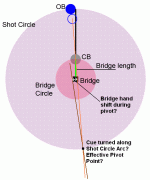Look, it's not a matter of rubbing anything anywhere. And thank you for the player comment. Actually, I'm with you 100% when it comes to what happens when I'm at the table in a match. (In fact, a long time ago I wrote something about the science of the game that you'd probably like *a lot.* I'll find and re-post it of you like.)
But nonetheless, I have found over the years, that knowing the science can help. I know that approaching the game with a good understanding of what is happening physically has made me a better player. Am I thinking about any of this when shooting? Absolutely not. But I understand better what's causing what and that can't hurt. Maybe if you're a natural and you were running 100s when you were so small you needed a soapbox to stand on around the table, the science is totally irrelevant. But most of us are not in that boat.
What I think everyone wants to know is: is there a scientific basis for this thing called CTE. How does it work? I don't think anyone doubts that it helps some players, and there have been a variety of theories proposed for why that is so.
I think most of us here like to share so that we all get better. Everything from answering questions about the best tips to use, to discussions about grips, bridges, eye position, stance, and everything else pool. People all across this and other forums have freely helped each other and maybe we've all learned a tidbit here or there that has taken us a little further up the mountain.
And that is what I think many find infuriating about CTE and its proponents: the claims that it works and has scientific validity, while being unable and/or unwilling to share and explain. Personally, I have said before that I think the reason it works is because it makes some players more systematic in their approach to lining up and aiming. Certainly, you would have to concede that purely as a matter of geometry, the system can't work (maybe not

and that's at the crux of the controversy. I think the CTE guys are worried that, if all is revealed, it will be shown that CTE is not 100% scientifically. But even that would not mean that CTE is not a good helpful useful thing, because there are a lot of things that aren't 100% when it comes to pool. There will always be the element of artistry needed to blend all the things like squirt and swerve and throw and spin, and speed, regardless of the system.
I know this isn't going to persuade anyone, but at this point I think it's time for both sides to let go. Without someone from the CTE side giving up a coherent explanation, this isn't going anywhere. But by the same token, if you're not willing to share and explain, you should stop with the claims and taunts, IMO.
Lou Figueroa
